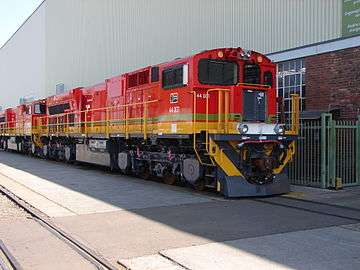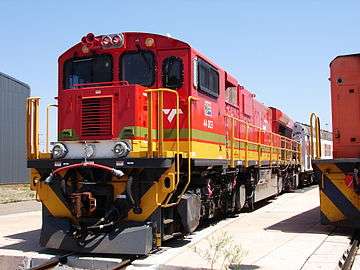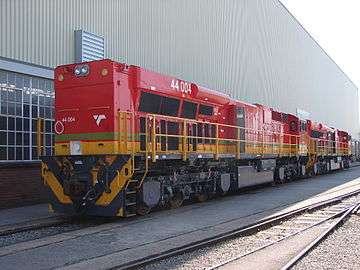South African Class 44-000
The Transnet Freight Rail Class 44-000 of 2015 is a South African diesel-electric locomotive.
| South African Class 44-000 | |||||||||||||||||||||||||||||||||||||||
|---|---|---|---|---|---|---|---|---|---|---|---|---|---|---|---|---|---|---|---|---|---|---|---|---|---|---|---|---|---|---|---|---|---|---|---|---|---|---|---|
 No. 44-005 at Koedoespoort, 29 September 2015 | |||||||||||||||||||||||||||||||||||||||
| |||||||||||||||||||||||||||||||||||||||
| |||||||||||||||||||||||||||||||||||||||
| |||||||||||||||||||||||||||||||||||||||
| |||||||||||||||||||||||||||||||||||||||
In 2015 Transnet Engineering at Koedoespoort in Pretoria took delivery of the first six of 233 Class 44-000 General Electric type ES40ACi diesel-electric locomotives for Transnet Freight Rail.
Manufacturers
The first six Class 44-000 locomotives were built in the United States of America by General Electric in Erie, Pennsylvania in April and July 2015. In October 2015 the first of 227 locally-built locomotives was nearing completion at the Koedoespoort shops in Pretoria, while the first two of the six imported locomotives were undergoing testing on the line between Pyramid South and Warmbad.[1]
The acquisition of the Class 44-000 forms part of the largest-ever locomotive supply contract in South African history and the single-biggest investment initiative by a South African corporation. It consists of contracts for the construction of 1,064 locomotives by four global original equipment manufacturers:[2][3][4]
- General Electric South Africa Technologies (a unit of the U.S.-based GE Transportation) for 233 Class 44-000 diesel-electric locomotives.[2]
- CNR Rolling Stock South Africa (Pty.) Ltd. for 232 Class 45-000 diesel-electric locomotives.[2]
- CSR Zhuzhou Electric Locomotive Company for 359 Class 22E dual-voltage electric locomotives.[2]
- Bombardier Transportation South Africa for 240 Class 23E dual-voltage electric locomotives.[2]
Construction


The Class 44-000 GE type ES40ACi diesel-electric locomotive was designed by GE Rail, a division of General Electric. While the forerunner Class 43-000 was, to a large extent, designed by GE for Cape gauge and bought "off the shelf", the Class 44-000 was designed and built to stringent specifications prescribed by Transnet Freight Rail.[5]
The core components of the Class 44-000, such as the GEVO-12 prime movers, were manufactured in the United States of America, with locomotive construction and final assembly taking place at Koedoespoort. This will be in compliance with the minimum local content criteria for rolling stock of 55% for diesel-electric locomotives.[2]
The six American-built locomotives, numbered in the range from 44-001 to 44-006, were all delivered to Transnet Engineering at Koedoespoort by September 2015. The first two, numbers 44-002 and 44-003, were at Pyramid South for testing and evaluation with a traction test vehicle on the line between Pyramid South and Warmbad, prior to road testing hauling freight. The rest are being built by Transnet Engineering and will be numbered in the range from 44-007 to 44-233.[5]
Works numbers
The GE-built Class 44-000 builder’s works numbers are shown in the table.
Loco no. |
Builder | Works no. |
Year |
|---|---|---|---|
| 44-001 | GE | 63325 | 2015-07 |
| 44-002 | GE | 63326 | 2015-04 |
| 44-003 | GE | 63327 | 2015-04 |
| 44-004 | GE | 63328 | 2015-07 |
| 44-005 | GE | 63329 | 2015-07 |
| 44-006 | GE | 63330 | 2015-07 |
| 44-007 | TE | 2015 | |
Illustration
All the Class 44-000 locomotives were delivered in red TFR livery. The reason for the pink colour of the chains on the bogies could not be determined.
 No. 44-001 at Koedoespoort. Pretoria, 29 September 2015
No. 44-001 at Koedoespoort. Pretoria, 29 September 2015 No. 44-003 at Pyramid South, 27 September 2015
No. 44-003 at Pyramid South, 27 September 2015 No. 44-004 at Koedoespoort. Pretoria, 29 September 2015
No. 44-004 at Koedoespoort. Pretoria, 29 September 2015
References
| Wikimedia Commons has media related to South African Class 44-000. |
- Railways Africa, 11 Feb 2015: New Transnet Diesel-Electric Locomotives (Accessed 22 Nov 2015)
- RailwayAge, 17 Mar 2014: Transnet: 1,064 locomotives, $5 billion (Accessed 23 Nov 2015)
- Railway Gazette, 4 Dec 2014: Transnet seals MoU with CSR Zhuzhou (Accessed 6 Feb 2016)
- Railway Gazette, 17 Mar 2014: South Africa's 'largest ever' locomotive order awarded to four suppliers (Accessed 6 Feb 2016)
- Transnet Loco Acquisition (Accessed 22 Nov 2015)